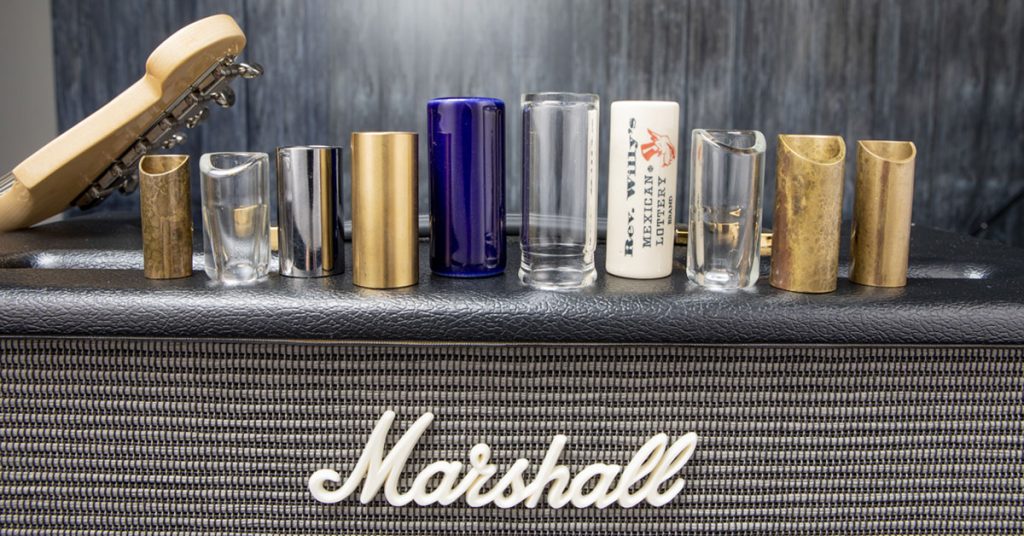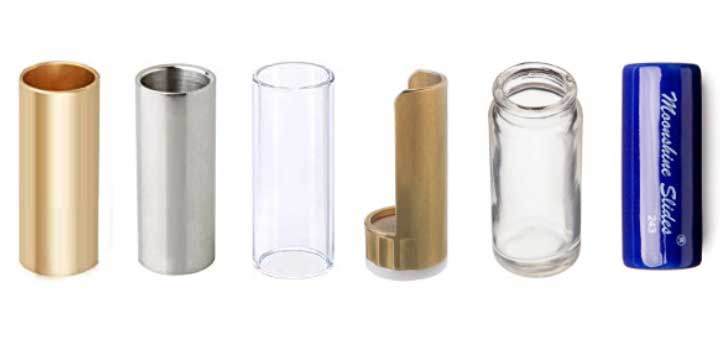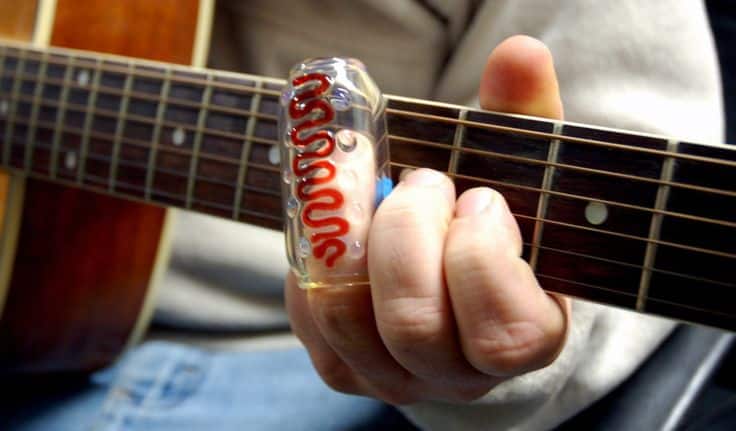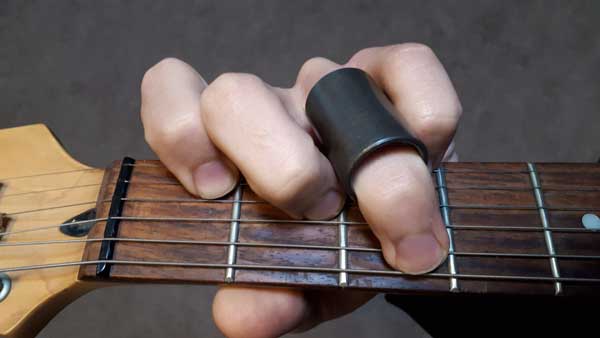Finding the perfect guitar slide can make all the difference in your playing, allowing you to effortlessly glide across the strings and create mesmerizing sounds. With so many options available, it can be overwhelming to choose the best one that suits your playing style and preferences. Fear not, because in this ultimate guide, we will explore the different types of guitar slides, their materials, sizes, and everything else you need to know to find the perfect slide for your guitar. So, let’s dive in and unleash your inner slide guitar legend!
1. Types of Guitar Slides
1.1 Glass Slides
Glass slides are popular among guitarists for their smooth and bright tone. They produce a clean, articulate sound that is ideal for playing blues, rock, and slide guitar. Glass slides are typically made from borosilicate glass, which is durable and offers excellent sustain. They come in various sizes and thicknesses to suit different playing styles and preferences.
1.2 Metal Slides
Metal slides are known for their versatility and durability. They are commonly made from materials such as steel, brass, or chrome, offering a different tonal character compared to glass slides. Metal slides produce a bright and cutting sound with good sustain, making them suitable for genres like rock, metal, and country. They are available in different sizes and weights, allowing guitarists to find the perfect fit for their playing style.
1.3 Ceramic Slides
Ceramic slides are less common but provide a unique tone and feel. They produce a warm and mellow sound with a subtle sustain. Ceramic slides are typically heavier than glass or metal slides, which can enhance their tone and projection. They are ideal for playing blues, acoustic, or folk music, as they offer a softer and more delicate sound. Ceramic slides are less prone to wear and tear and can be a great option for guitarists looking for longevity.
1.4 Brass Slides
Brass slides are a popular choice for guitarists who prefer a heavier slide and a bright, penetrating tone. Brass slides provide a unique combination of warmth and brightness, making them suitable for a wide range of genres. They offer a good sustain and excellent projection, allowing the guitarist’s playing to cut through the mix. Brass slides are also highly durable, making them a favorite among many experienced guitarists.
2. Different Sizes of Guitar Slides
2.1 Small Slides
Small slides are typically around 1 inch or shorter in length. They are ideal for players with smaller hands or those who prefer a more precise control over their playing. Small slides offer a tighter grip and can provide greater accuracy when navigating the fretboard. They are commonly used for playing intricate melodies or in situations where precise intonation is required.
2.2 Medium Slides
Medium slides are the most commonly used size and are approximately 1.5 to 2 inches long. They offer a good balance between control and reach. Medium slides are versatile and suitable for various playing styles and genres. They provide a comfortable fit for most guitarists and are a great option for both lead and rhythm playing.
2.3 Large Slides
Large slides, typically over 2 inches in length, are preferred by guitarists who prioritize sustain and volume. They offer a wider contact area with the strings, resulting in a fuller sound with increased sustain. Large slides can be beneficial for playing slide guitar solos or in situations where a powerful and resonant tone is desired.
3. Choosing the Right Material
3.1 Sound Quality
When choosing a guitar slide, it’s important to consider the sound quality you desire. Glass slides generally produce a brighter and clearer tone, while metal slides offer a crisper and more cutting sound. Ceramic slides provide a warmer and mellower tone, while brass slides offer a unique combination of warmth and brightness. Consider the genre and playing style you prefer to find the material that best complements your sound.
3.2 Comfort
Comfort is crucial when choosing a guitar slide, as it directly affects your playing experience. Glass and ceramic slides are generally smoother and more comfortable against the fingers, providing a more effortless glide along the strings. Metal and brass slides may feel slightly heavier and require more finger strength. Consider your hand size, finger dexterity, and personal comfort preferences when selecting a slide material.
3.3 Durability
Different slide materials vary in their durability. Glass slides are relatively fragile and can break if dropped or mishandled. Metal slides are more robust and resistant to damage, while ceramic slides offer excellent durability with their sturdy construction. Brass slides are also highly durable and can withstand heavy use. Consider your playing environment and how often you intend to use the slide to choose a material that is suitable for your needs.
4. Understanding Tone and Sound
4.1 Bright and Clear Tones
Bright and clear tones are characterized by their crisp and articulate sound. Glass slides are known for producing this type of tone, making them popular among guitarists who want to achieve clarity and precision in their playing. Bright tones are often favored in genres like blues, rock, and slide guitar, where every note needs to stand out in a mix.
4.2 Warm and Mellow Tones
Warm and mellow tones have a softer and more rounded sound. Ceramic slides excel in producing warm tones, perfect for playing blues, acoustic, or folk music. The inherent warmth of ceramic slides adds a pleasant coloration to the notes, creating a more intimate and soothing sound that complements slower, melodic playing.
4.3 Balanced Tones
Balanced tones strike a middle ground between bright and warm tones, offering a versatile sound that can suit various genres. Metal slides, particularly brass, deliver a balanced tone with both brightness and warmth. This balance allows the slide to cut through the mix while retaining a touch of richness and depth.
5. Slide Fit and Sizing
5.1 Snug Fit vs. Loose Fit
The fit of a guitar slide can significantly impact your playing experience. A snug fit provides better control and allows for more precise intonation. It prevents the slide from moving around and ensures a clear and accurate sound. However, some guitarists prefer a slightly loose fit, as it offers more freedom for vibrato and bending techniques. Experiment with both snug and loose fits to find the one that feels most comfortable and suits your playing style.
5.2 Finding the Right Size
Finding the right size of a guitar slide is crucial for optimal playability. Small slides are suitable for players with smaller hands or those who prefer a tighter grip. Medium slides offer a balance between control and reach and are a versatile choice for most guitarists. Large slides provide more sustain and volume, making them ideal for specific playing styles. Consider the length and width of the slide, as well as your hand size and playing preferences, when selecting the right size for you.
6. Slide Techniques and Playing Styles
6.1 Standard Sliding Technique
The standard sliding technique involves using the slide to smoothly glide along the strings, creating fluid and seamless transitions between notes. It is important to maintain a consistent pressure and contact with the strings to produce clear and well-defined tones. Experiment with different finger placements, angles, and pressures to find the technique that works best for you.
6.2 Vibrato and Bending
Vibrato and bending techniques can add expressiveness and dynamics to your slide playing. Vibrato involves subtly altering the pitch of a sustained note by moving the slide back and forth or side to side. Bending, on the other hand, involves bending the strings while applying pressure with the slide. These techniques require practice and control to achieve the desired effect and can greatly enhance your slide playing.
6.3 Open Tunings and Slide Guitar
Open tunings are commonly used in slide guitar playing to achieve specific chord structures and harmonies. By tuning the guitar to a particular open chord, such as open D or open G, you can easily play chords by barring the strings with the slide. This technique allows for more freedom in exploring the fretboard and creating different chord voicings. Experiment with different open tunings to expand your slide guitar repertoire.
7. Budget Considerations
7.1 High-End Slides
High-end guitar slides are often crafted with precision and superior materials, resulting in exceptional sound quality and durability. They are handmade or produced by reputable manufacturers who prioritize craftsmanship. High-end slides can be more expensive, but if you are a professional or serious guitarist seeking the best possible slide experience, investing in a high-end slide may be worth considering.
7.2 Mid-Range Slides
Mid-range slides offer a good balance between quality and affordability. They are generally manufactured with decent craftsmanship and materials, providing satisfactory performance for most guitarists. Mid-range slides are suitable for both beginners and intermediate players who want a reliable slide without breaking the bank.
7.3 Budget-Friendly Options
For guitarists on a budget or beginners who want to experiment with slide playing, there are various budget-friendly options available. These slides are often mass-produced and made from basic materials but can still offer a decent sound and usability. Budget-friendly slides are a great starting point for those who want to explore slide guitar without making a significant investment.
8. Testing and Trying Out Slides
8.1 In-Store Testing
One of the best ways to find the perfect guitar slide is to try them out in person. Visit a music store and request to test different slides on your own guitar. Pay attention to the comfort, sound quality, and fit of each slide. Experiment with various techniques, such as sliding, vibrato, and bending, to gauge the slide’s performance. In-store testing allows you to make an informed decision based on firsthand experience.
8.2 Online Reviews and Recommendations
If visiting a physical store is not possible, online reviews and recommendations can be helpful in narrowing down your options. Read reviews from other guitarists who have used the slides you are interested in purchasing. Look for feedback on sound quality, durability, and comfort. Additionally, seek recommendations from trusted sources or online guitar communities to gather valuable insights and make an informed choice.
8.3 Borrowing from Friends
If you have friends who play slide guitar, consider asking to borrow their slides to try them out. This allows you to get a feel for different materials, sizes, and brands without committing to a purchase. By borrowing slides from friends, you can gain firsthand experience before making a decision and even get their recommendations based on their personal preferences.
9. Maintenance and Care Tips
9.1 Cleaning Slides
Regular cleaning is essential to maintain the quality and longevity of your guitar slide. Glass and ceramic slides can be cleaned with mild soap and warm water, making sure to rinse and dry thoroughly afterward. Metal and brass slides can be polished with a soft cloth or metal polishing agent to remove any tarnish or oxidation. Proper cleaning ensures that your slide remains in optimal condition and produces the best possible sound.
9.2 Avoiding Damage
To prevent damage to your guitar slide, handle it with care. Avoid dropping or banging the slide against hard surfaces, as this can lead to cracks or chips, especially with glass slides. Be mindful of accidental contact with the guitar strings, as undue pressure or sudden impact can cause damage to both the slide and the guitar itself. Treat your guitar slide as a precious tool that deserves proper attention and care.
9.3 Storage
When not in use, store your guitar slide in a safe and dry environment. Consider using a slide case or pouch to protect it from dust, moisture, and physical damage. Keep the slide away from extreme temperatures or direct sunlight, as these conditions can potentially affect its material and quality. Proper storage ensures that your slide remains in optimal condition and ready for use whenever inspiration strikes.
10. Popular Brands and Recommendations
10.1 Dunlop
Dunlop is a renowned brand in the guitar industry, offering a wide range of guitar slides suitable for various playing styles and preferences. Their glass slides provide excellent tone and sustain, while their metal slides deliver cutting sound and durability. Dunlop slides are favored by many professional guitarists due to their reliability and quality craftsmanship.
10.2 Rocky Mountain Slides
Rocky Mountain Slides is a notable brand specializing in handcrafted guitar slides. They offer slides made from glass, metal, ceramic, and other unique materials, providing an extensive selection for guitarists. Rocky Mountain Slides focus on producing slides that offer exceptional sound quality and comfortable playing experience, catering to the needs of both beginners and experienced players.
10.3 Glasser
Glasser is known for its high-quality glass slides, producing clarity and brightness in sound. They offer a range of sizes and thicknesses to accommodate different playing styles. Glasser slides are meticulously crafted, ensuring a comfortable fit and excellent sustain. With their commitment to craftsmanship and attention to detail, Glasser is a trusted brand among guitarists.
10.4 Shubb
Shubb is recognized for its versatile and adjustable guitar slides. Their brass slides feature a patented design that allows players to adjust the fit to their finger size, providing a secure and comfortable grip. Shubb slides are highly durable and produce a balanced tone with both warmth and brightness. With their innovative approach and dedication to customer satisfaction, Shubb is a recommended brand for guitarists seeking flexibility and adaptability in their slide playing.
In conclusion, finding the best guitar slide involves considering various factors such as material, size, sound quality, fit, and budget. By understanding the different types of guitar slides, their characteristics, and how they can enhance your playing, you can make an informed decision. Remember to test and try out slides, seek recommendations, and take care of your slide through regular maintenance. With the right slide, you can unlock new creative possibilities and elevate your guitar playing to new heights.











